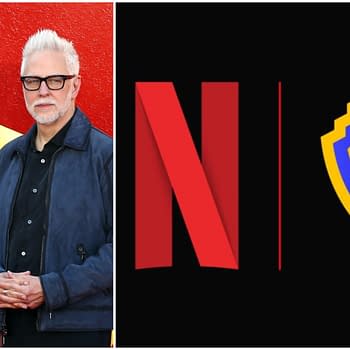Posted in: Comics, Recent Updates | Tagged: Bob Harras, dan didio, guillermo del toro, jim lee, marv wolfman, michael shannon, neal adams, Necessary Evil Super-Villains of DC Comics, New York Comic Con 2013, scott snyder, zack snyder
World Premier of Necessary Evil: Super-Villains of DC Comics at NYCC Is A Win For The Uber-Fan
New York Comic Con hosted the first ever public screening of a much talked about new documentary drawing together interviews with comic writers, editors, artists, actors in hero films, professional psychiatrists and more to talk about the mysterious but dominant pull that DC supervillains hold in pop culture in Necessary Evil: Super-Villains of DC Comics. The documentary is produced by DC Comics and mOcean, directed by Scott Devine, and J.M. Kenny, and debuts in cinemas October 25th.

Scott Snyder, Jim Lee, Dan Didio, Zack Snyder, Guillermo Del Toro, and Marv Wolfman feature exploring the role and haunting qualities of super-villains in general. Here are some of their thoughts and questions they raise from the documentary:
Jim Lee: [Super-villains] are very much in a symbiotic relationship, in that if the villains were to off the hero, they'd find themselves a little listless.
Scott Snyder: What the Joker says [to Batman] is that the rogues gallery, is that all of us love you, all of us are here to make yourself a better superhero.
Dan Didio: Did the costume villain arise first and the hero was invented to keep him from getting more powerful?
Jim Lee: I would like to think that most people identify with the hero, but in this day and age, there may be some who identify with the villain.
Guillermo del Toro: Supervillains represent everything that we fear or everything that we need to fight against.
Scott Snyder: [Super-villains] are our personal demons. All of us face those things in our lives when you're positive you're not going to make it through this one. Thinking to yourself "I'm not capable of overcoming this". The hero represents all we hope that humanity is capable of overcoming. It says that we can too.
Zack Snyder: The best villains have gone bad but are not all bad, and horrible incidents occur to keep them down that path.
Scott Snyder: Why can't you just go left instead of right at that seminal moment? Falling victim to difficult circumstances, gets you into Arkham.
Marv Wolfman: Their strength comes from 100 percent certainty that they are correct.
Jim Lee: In the 50's, the idea of a superman is reassuring. In today's day and age, I don't know if that's as reassuring. So the idea that there's a businessman looking out for fellow humans against a threat that can't be controlled speaks to a lot of people's fears about power and authority today [regarding Lex Luthor].
But thing get very specific in the documentary, too, about major and minor villains, with equal thought and consideration given whether big names or not. Dark Seid, Star Sapphire, General Zod, Black Manta, the Riddler, Sinestro, Lobo, Man-Bat, and many more all get the star villain treatment for the film by Neal Adams, Michael Shannon, Bob Harras, and many more:
Neal Adams: Man-Bat is a genius, scientist, but just a little off. He thinks he can create a serum out of bats and give to Batman, but somebody has to test it. It's Jekyll and Hyde. He becomes a man-bat. Not a villain. He can be manipulated by villains but he loves Batman and wants to be like Batman. He becomes a drug addict and a monster.
Michael Shannon (who portrayed Zod in Man of Steel): I think Superman and Zod could fight for centuries. The person who is going to win that fight is the person who puts the most heart into it.
Bob Harras: There's the "cosmic level" danger villain. They can cross time and space, represent a threat that only a hero of that level can face and that's why they are almost more frightening.
Neal Adams: We need a Moriarity for Sherlock Holmes, and that's Ra's Al Ghul to Batman.
The breadth of the documentary was impressive, and the passionate commentary from pros that really showed off their inner fanboy was a major selling point. For those who are new to villains of the DCU, there's plenty of broad commentary on the psychology of super-villains and even of heroes in relationship to them, but the biggest draw for serious comics readers will be those insider comments that spotlight their own personal favorites in the underworld of the DCU.
Hannah Means-Shannon is Senior New York Correspondent at Bleeding Cool, writes and blogs about comics for TRIP CITY and Sequart.org, and is currently working on books about Neil Gaiman and Alan Moore for Sequart. She is @hannahmenzies on Twitter and hannahmenziesblog on WordPress. Find her bio here.















